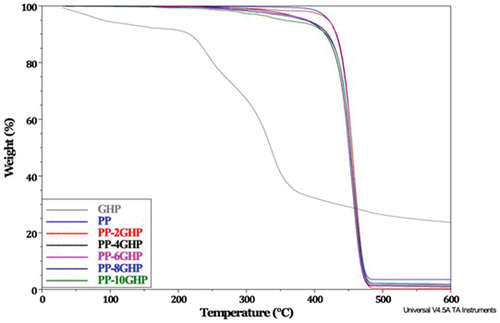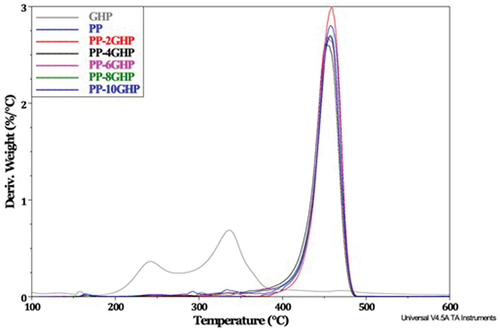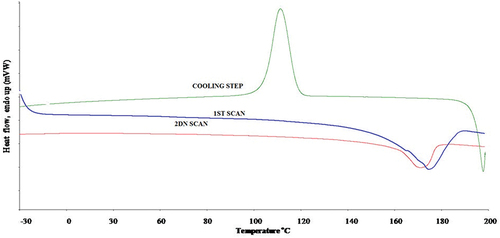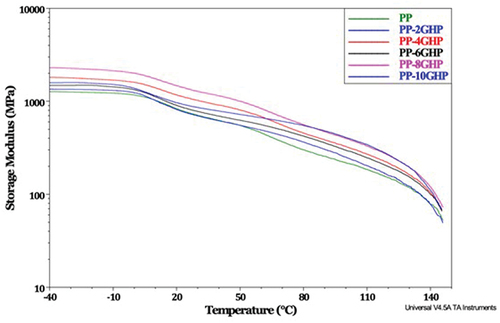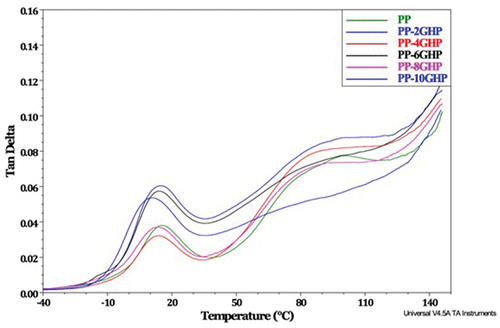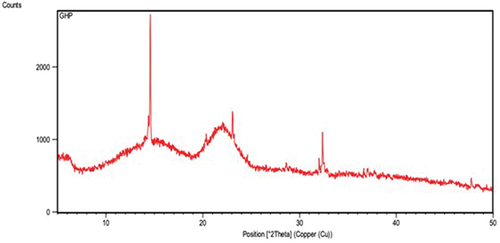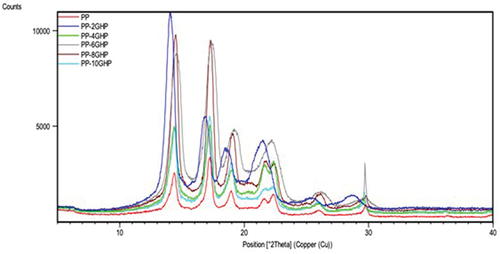ABSTRACT
The use of biowaste materials as additives in polymeric matrices has generated interest. Garlic is a seed that has wide application areas, not only in the food industry, because it has good bactericidal and antioxidant properties. Polypropylene (PP) is a commodity polymer that has a wide range of applications, including containers, construction materials, automotive parts, domestic issues, etc. In the present work, the obtaining of composite materials based on a Polypropylene with a medium melt flow index as a matrix and as a reinforcing agent garlic husk particles (GHP). The addition of GHP in different contents was evaluated (2 to 10 PHR), and the composites were characterized by thermogravimetric analysis (TGA), differential scanning calorimetry (DSC), dynamic mechanical analysis (DMA) and X-ray diffraction (×RD). According to the results, the thermal stability of PP-GHP decreases with the GHP, in addition to the results of DSC and XRD, that showed that the crystallinity of PP-GHP composites was higher compared to the pristine PP. DMA results allow us to identify that the addition of GHP generates a reinforcing effect on PP matrix, which means that this waste material can be considered a bioadditive with positive effects on polymeric matrices.
摘要
在聚合物基质中使用生物废料作为添加剂引起了人们的兴趣。大蒜是一种应用广泛的种子,不仅在食品工业中,因为它具有良好的杀菌和抗氧化性能. 聚丙烯(PP)是一种应用广泛的商品聚合物,包括容器、建筑材料、汽车零部件、国内问题等. 在本工作中,获得了基于聚丙烯的复合材料,该聚丙烯具有中等熔体流动指数作为基质,并作为增强剂大蒜壳颗粒(GHP). 对不同含量的GHP的添加进行了评估(2至10PHR),并通过热重分析(TGA)、差示扫描量热法(DSC)、动态力学分析(DMA)和X射线衍射(XRD)对复合材料进行了表征. 根据结果,除了DSC和XRD的结果外,PP-GHP的热稳定性随着GHP的降低而降低,这表明PP-GHP复合材料的结晶度高于原始PP. DMA结果允许我们确定GHP的添加对PP基质产生增强作用,这意味着该废料可以被视为对聚合物基质具有积极作用的生物加性材料.
Introduction
The processing of polymeric composites that use bio waste materials as reinforcements has captured the engineering and commercial interest to produce composites that have application areas such as interior and exterior automotive parts, pavements, the construction industry, door and windows, furniture, packaging materials, toys, profiles for kitchen cabinets, among others (Chitra and Vasanthakumari Citation2012; Essabir et al. Citation2013). Advances in their production have focused on mechanical improvement and reduction of structural defects to ensure safety, reliability, cost reduction, and increased production rates (Ashori and Nourbakhsh Citation2010; Koay, Husseinsyah, and Osman Citation2013; Prithivirajan, Jayabal, and Bharathiraja Citation2015; Raghu et al. Citation2018; Samariha et al. Citation2013; Singh et al. Citation2019).
The most popular thermoplastic polymer matrices for this type of composite material are polyolefins such as polypropylene (PP). PP is one of the best-known polymers, which has many advantages, such as easy processing, corrosion resistance, mechanical stiffness, low density, and low cost. Among polyolefins, PP matrix has the highest modulus of elasticity and, at the same time, a melting temperature below 175ºC, in addition to its good chemical resistance, which allows it to resist in acid and alkaline environments (Ashori and Nourbakhsh Citation2010; Awang, Mohd, and Sarifuddin Citation2019; Dimzoski et al. Citation2009; Kajaks et al. Citation2014; Machado et al. Citation2005; Nourbakhsh, Ashori, and Tabrizi Citation2014; Prithivirajan, Jayabal, and Bharathiraja Citation2015; Yiga et al. Citation2020).
Natural fiber fillers have been used in polymer as they have some advantages over traditional fillers and reinforcements, including low density, flexibility during processing, acceptable specific strength, and low cost per volume (Ashori and Nourbakhsh Citation2010; Kajaks et al. Citation2014; Koay, Husseinsyah, and Osman Citation2013; Prithivirajan, Jayabal, and Bharathiraja Citation2015; Raghu et al. Citation2018; oSingh et al. Citation2019; Yiga et al. Citation2020).
Natural fibers are obtained from various plant fibers such as bast (stem or soft sclerenchyma), leaves or hard fibers, seeds, fruits, wood, cereal straw and other plant fibers. Currently, fibers obtained from various sources such as cotton, flax, hemp, jute and sisal are widely used industrially. In addition to these popular fibers, there are many other plant and agricultural residues or by-products with high potential for biopolymeric fiber suitable for industrial applications.
Some of the natural fillers that have been tested as reinforcement in polymeric compounds are wheat straw, bagasse, argan nut shells, sunflower stems, corn husks, furfural husks, banana husks, rice hulls, coconut, peanut shell, pistachio shell, among others, but it is worth mentioning that garlic shell stands out among the underutilized agricultural waste resources, being a promising material as additive for polymeric matrices (Hansen, Arancibia, and Gutiérrez Citation2010; Hernández-Varela et al. Citation2021; Kallel et al. Citation2016; Moreno et al. Citation2020; Reddy and Rhim Citation2014), in our group recently we reported the use of pistachio, Jatropha curcas shell particles as bioadditive for PP (Rivera-Armenta et al. Citation2022; Salazar-Cruz et al. Citation2022).
Garlic has been widely used due to its culinary and medicinal attributes, it has been used in the preparation of fruit and vegetable coatings, for the extraction of antioxidants and for the elimination of contaminants such as hexavalent chromium (Chen et al. Citation2018; Hawal, Al-Sulttani, and Kariem Citation2021; Hussain et al. Citation2021; Liu et al. Citation2014; Parlayıcı and Pehlivan Citation2015; Sun et al. Citation2018), but the use of its husks as a filler in a polymeric matrix is null; for this reason, in this study the main objective is the preparation of PP-based composite materials, which were reinforced with garlic husk particles (GHP), in order to evaluate their thermal properties. Composite materials were prepared from PP and GHP by the melt blending method, and the materials were evaluated for thermal and physicochemical properties by means of differential scanning calorimetry (DSC), thermogravimetry (TGA), X-ray diffraction (×RD) and dynamic mechanical analysis (DMA).
Experimental
Materials and methods
PP homopolymer with the following characteristics was used as a matrix: melt flow rate (MFR) 12 g/10 min (ASTM1238), density of 0.9 g/cm3, material that was donated by the company Indelpro S.A. of C.V. Altamira, Mexico. GHP were collected domestically, and received the following treatment: GHP were washed with distilled water and dried in oven at 40ºC, later they were milled to reduce the size in an IKA analytical mill model A11 and later the ground material was sieved to obtain a homogeneous particle size with mesh # 80 (177 micrometers).
Composites preparation
The PP composite materials with GHP were prepared by the melt mixing method, using a Brabender plastic-corder with a 60 cm3 mixing chamber, using Roller-type blades, the mixing conditions were 180ºC, with 15 min and 60 rpm. GHP content was varied in 2, 4, 6, 8 and 10 PHR (parts per hundred of resin). The composites were identified with codes depending of GHP content as: PP-2GHP, PP-4GHP, PP-6GHP, PP-8GHP and PP-10GHP, which correspond to 2, 4, 6, 8, and 10 PHR GHP content respectively.
Composites characterization
With the purpose of evaluating the effect of the addition of GHP on the composites properties, the following characterization techniques were performed: the thermal stability was evaluated using a Simultaneous Thermal Analyzer (SDT, DSC/TGA) TA Instruments, model Q600, with a heating rate of 10ºC/min in a temperature range from room temperature to 600ºC, in a Nitrogen environment with a flow of 100 ml/min and alumina crucible. The crystallization and melting behavior of composites were evaluated using a Perkin Elmer Differential Scanning Calorimeter (DSC), model DSC8000 equipment, under a Nitrogen atmosphere with a flow of 20 ml/min, with a temperature range of −40 to 200ºC, with a double heating cycle, in which the first was used to delete the thermal history of the material with a heating rate of 20ºC/min, and the cooling cycle was used to determine the crystallization temperature (Tc) and ∆Hc, and finally, a second heating step was carried out with heating rate of 10ºC/min, the melting temperature was identified and the melting peak ∆Hm was determined, and the degree of crystallinity (×c) was determinate by the following equation: Xc = (∆Hf/∆Hºf)*100 (Ruíz-Orta et al Citation2011]. ∆Hf is the enthalpy of fusion per unit of mass of PP, calculated from the area under the melting peak, ∆Hºf is the enthalpy per unit of mass of the 100% crystalline PP, with a value of 207 J/g (Bazan, Salasinska, and Kuciel (Citation2021). The dynamic mechanical properties were determinate using a TA Instruments DMA model Q800 equipment coupled with an ACS3 cooling system, the analysis conditions were a temperature range of −40 to 150ºC, with a heating rate of 5ºC/min, using a fix frequency of 1 Hz and a Dual Cantilever clamp, the storage modulus (E`) and tan δ curves were reported. Finally, to evaluate the composites structural properties, a X-ray diffraction analysis was carried out using a Bruker model D8 Advance equipment, with a range of 5 to 40º on the 2 Ѳ scale, with a step size of 0.02º, a voltage of 40kV, a current of 40 mA and a radiation of Ka from Cu (0.15405 nm).
Results and discussion
TGA results
shows the TGA thermogram of the GHP, the PP and PP-GHP composites. The thermal degradation of lignocellulosic compounds depends on the structure and its chemical composition. In the case GHP shows 3 weight loss steps, which are typical of lignocellulosic materials (Carrier et al. Citation2011): the first around 150ºC due to the release of water and some extractable (oils, resins, soils, etc.) in approximately 10%, later around 230ºC it presents a weight loss attributed to the decomposition of pectin and other polysaccharides (hemicellulose) that are part of GHP, the third around 350ºC attributed to the decomposition of the cellulose and lignin, a temperature that is above the value reported in previous works (Reddy and Rhim Citation2014; Moreno et al Citation2020) who report temperatures between 310 and 330ºC, this difference being due to the content of cellulose and other polysaccharides, which vary according to the region where it is produced, and also has a residue content of approximately 25%, was lower than that reported by these groups.
In the case of composites, PP presents a single decomposition stage, with an onset temperature of 416ºC, and a low ash content at the end of the analysis. It can be seen that as the content of GHP increases, its the onset temperature is lower than pure PP, this is attributed to the nature of the particles, the composite with lower onset temperature is PP-6GHP, with 394ºC. On the other hand, for a better identification of the decomposition temperature, presents the weight loss derivative (DTG) and reports te peak temperature of DTG curve (Tp), which represents the medium decomposition temperature for the composites and helps to identify the decomposition susceptibility of a material with average temperature (Rivera-Armenta et al. Citation2022). According with and , the Tp value decreases for PP-4GHP composite compared with pristine PP, and when GHP increases the Tp reaches the Tp of PP, suggesting that higher content has not effect one this temperature. However, an interesting observation is that the ratio of the Tp value shows a decrease as the GHP content increases, which represents a lower susceptibility to weight loss. From the previous results it is determined that the presence of GHP decreases the thermal stability of the PP matrix, this behavior has been reported for PP reinforced with different lignocellulosic materials (Nuñez et al. Citation2002). On the other hand, the thermal stability of PP resins has been improved when lignocellulosic materials have been modified on their surface or chemically (Salazar-Cruz et al. Citation2022) or fiber such as bamboo (Nayak, Mohanty, and Samal Citation2009). shows the onset temperature and Tp of the DTG curve, in which it can be seen how the thermal stability of the compounds decreases as the content of GHP increases until 6GHP and then increase for 8 and 10GHP.
Table 1. Melting and crystallization properties for PP and PP-GHP composites obtained from DSC and Onset temperature and Tp from TGA.
DSC results
The effect of addition of GHP over crystallization (crystallization temperature data (Tc), the crystallization enthalpy (∆HC)) and melting process (melting temperature (Tm), melting enthalpy (∆Hm) and % Xc) of PP and PP-GHP composites was evaluated using DSC, reported values represent the average of duplicate analysis of each sample. depicts the DSC thermogram of PP and all the composites present the same behavior. reports the complete data of the PP and PP-GHP composites. The crystallization process of PP depends on factors such as conditions in crystallization takes place and structural factors such as tacticity, melt flow and molecular weight. From obtained results, it can be observed that at low contents of GHP, there is a slight shift in the Tc to values above the temperature of pristine PP, in addition to the fact that the ∆Hc show slightly lower values compared to the pristine PP, these values are lower than those reported in other works, attributed to differences on Melt Flow (Nuñez et al. Citation2002; Salazar-Cruz et al. Citation2022). On the other hand, in the case of melting process, there is a slight shift in temperature (2-3ºC) to lower values, the most significant being for PP-8GHP composite, which shows a difference of 4ºC. Generally, in thermal analysis, to consider the effect of a variable on the thermal property of a material, the temperature difference must be minimum 5ºC, so in this case the addition of GHP does not affect the Tc and Tm. Where a difference does occur is in the % Xc, which increases for all the composites with the incorporation of GHP, which can be explained as the particles generating a nucleating effect in the PP matrix, attributed to a better interfacial interaction between the particles and polymer matrix. This behavior has been previously reported (Quillin, Caulfield, and Koutsky Citation1993; Salazar-Cruz et al. Citation2022), attributing the improvement to the favoring of the interfacial interaction between the lignocellulosic particles and the PP matrix, forming a transcrystalline region around the particles, also reflecting a higher order of the chains, and formation of nucleation sites in presence of particles, thereby increasing the crystallinity. The only material that did not shows a trend was PP-8GHP composite, which presented a crystallinity very similar to that of the pristine PP. Other reports found that the presence of natural waste materials produce a decrease in the % Xc of up to 11% (Melo et al. Citation2021).
It is worth mentioning that the %Xc for PP composites with lignocellulosic materials depends on the properties of the PP, since according to its tacticity these properties can increase. Some of the reports of composites using PP as a matrix have reported crystallinity values close to 40%, but with PP that has a lower Melt Flow value (3.3 g/10 min) (Salazar-Cruz et al. Citation2022). Other works such as Nuñez et al. (Citation2002) reported crystallinity of 37%, for a PP with flow rate of 17 g/10 min, reinforced with chemically modified woodflour, but in that work they evaluated the addition of a malefic anhydride base coupling agent, with which the integration of the particles in the PP matrix was improved.
DMA results
Dynamic Mechanical Analysis (DMA) is a widely used technique to evaluate the viscoelastic response of a polymer by applying a dynamic heating ramp that reflects molecular movements that translate into changes in the storage modulus, these changes are known as molecular relaxations (Kaelble Citation1969) and the effect of particulate or reinforced materials in a polymeric matrix, in addition to stiffness.
The storage modulus is a property that relates the ability to withstand stress without deforming. shows the DMA thermogram showing the variation of the storage modulus with respect to temperature. It can be seen that at low temperatures, with the exception of the PP-2 GHP composite, the composites presented similar storage modulus value or higher than the pristine PP, indicating that the addition of the particles generates a favorable effect on this property, the maximum value was presented by PP-8GHP. The increase in storage modulus is related to the stiffness of the material due to the presence of rigid fillers in a semi-rigid matrix such as PP. The foregoing is also related to the reinforcing effect generated by the presence of the GHP, so that it can be inferred that the rigidity of the material is increased with the addition of the particles, which produce a decrease in the movement capacity of the material polymer chains. Previous works reports that use of lignocellulosic materials such seed husk of sunflower or pistachio, favor the increase of storage modulus, attributing this to a good interaction between particles and polymeric matrix (Salasinska and Ryszkowska Citation2015).
Regarding the Tan δ (), the maximum of the peak is taken as the Tg of the amorphous domains of the PP matrix, when there is an increase in the value of the Tg in composites, it is mainly due to the decrease in mobility of the segments of the main polymer chain, in addition to this signal being used to understand the influence of fillers on the thermomechanical response of polymers. shows the DMA thermogram of Tan δ with respect to temperature, and the presence of two relaxation signals can be observed, the first around 12ºC, which is associated with the Tg of the composites, which does not present a considerable variation in the maximum of the peak, that is, of the Tg of the composites with respect to the pristine PP. However, the main variation is presented in the Tan δ ratio, being lower for the PP-4GHP and PP-8GHP composites, which is associated with a restriction of molecular movements, and therefore the dissipation energy is reduced, and mechanical relaxations are attenuated. In addition, the reduction is associated with a good adhesion of the particles to the PP matrix (Izwan et al. Citation2021). Another interesting aspect is the width of the peak, an increase in the width of the peak is associated with the fact that molecular relaxations take place in the composite, while these do not occur in the pure matrix. This molecular relaxations are associated with better dispersion of particles in matrix.
XRD results
shows the X-ray diffraction pattern of GHP, it is possible to observes the characteristic signals of the cellulosic components. Firstly, it is possible to observe a signal that appears as a “hump” which is caused by overlapping of the signals at 2Ѳ≈ 15° and 16°. With the Miller indices (110) and (110) respectively, this peak has been mistakenly identified as the signal from the amorphous peak (French Citation2020). It is also possible to identify the signal near a at 2Ѳ≈ 22° with Miller indices (002) corresponding to the crystallographic plane of cellulose. depicts the diffraction patterns of the PP-GHP composites. Firstly, the diffraction pattern corresponding to PP shows the characteristic peaks at 2Ѳ≈ 14°, 17°, 18° and 26°Corresponding monocyclic structure of α-form of PP with the planes (110), (040), (130) and (060) (Wang et al. Citation2017), the peaks at 2Ѳ≈ 21.5° and 22 .5° are originated by the signals with planes α(111)+ β(311) and α(311) + β(041), these signals with characteristics of PP (Somani et al. Citation2001). For composite PP-2GHP composite, it is possible to appreciate a displacement in all the peak at smaller angles, indicating an expansion of the basal space, which suggests that particles penetrate the PP chains (Ijdo and Pinnavaia Citation1998), likewise the signals with the planes α(111) + β(311) and α (311) + β(041), present an overlap generating a single signal that appears close to 21 ° indicating that this material has a contribution of the α-form greater or almost null than the β-phase (Rajesh, Somani et al. Citation2001). It is possible to appreciate that the PP-4GHP and PP-10GHP composites show signals very similar to those of PP with a slight shift toward higher angles. However, the PP-6GHP, and PP-8GHP composites all the signals appear at higher angles compared with PP, this indicates a compaction effect in the polymeric chains, as well as the PP-2GHP composite, the signals caused by the planes α (111) + β (311) and α (311) + β(041) suffer an overlap, originating a single peak denoting a greater contribution by the β-form of the PP (Samios, Tokumoto, and Denerdin Citation2005). In the case of the PP-8GHP composite, both signals (of the α and β phases) appear without significant change. The PP and the PP-2GHP composite show the signal at 2Ѳ = 28° belonging to the α-form that corresponds to the plane (200) without any change, however, the rest of the composites show a marked shift towards higher angles, denoting a clear compression effect, being the PP-6GHP composite the one that presents a signal with a higher intensity indicating an α-form with a higher degree of ordering (Supaphol and Lin Citation2001).
Conclusions
The performance characteristics PP-GHP composites have been studied and the following conclusions have been stablished. According with TGA results, the addition of GHP to a PP matrix is an interesting option for bioadditive in content from 2 to 10 phr, the thermal stability of PP was decreased by addition of GHP, being the composite PP-2GHP which shows a similar behavior than pristine PP, and according with DTG the susceptibility for thermal decomposition was lower for PP-GHP composites, that means GHP decrease the velocity for decomposition. The addition of GHP modify the crystallinity of PP-GHP composites, as it was demonstrated by DSC results, increasing the content compared with PP pristine, the XRD results show the presence of α and β-form crystals of PP that were modified by addition of GHP which causes a penetration of particles in polymer chains which reflect in an expansion of basal space. The DMA results show that Tg did not being affected by presence of GHP, but the stiffness was improved being the PP-8GHP composite which present the higher value, associated with increase of stiffness due a good interaction between GHP and PP matrix.
Highlights
The garlic husk particles (GHP) was not previously reported as polymer additive (filler, reinforcer).
The thermal stability was diminished with addition of GHP.
There is a reinforcer effect on composites with addition of GHP.
The crystallinity content of Polypropylene was increased with addition of GHP.
Acknowledgments
The authors are grateful to Indelpro, S.A. de C.V., Altamira, Tams., México, for providing the PP used in this work. Also wish to thanks to TA Instruments technical staff (Fabian Martínez and Edgar Ramirez) for technical support in DMA. This research was carried out in the postgraduate course in Master of Science in Chemical Engineering (MCIQ).
Disclosure statement
No potential conflict of interest was reported by the author(s).
Correction Statement
This article has been corrected with minor changes. These changes do not impact the academic content of the article.
Additional information
Funding
References
- Ashori, A., and A. Nourbakhsh. 2010. Bio-based composites from waste agricultural residues. Waste management 30 (4):1–12. doi:10.1016/j.wasman.2009.08.003.
- Awang, M., W. R. W. Mohd, and N. Sarifuddin. 2019. Study the effects of an addition of titanium dioxide (TiO2) on the mechanical and thermal properties of polypropylene-rice husk green composites. Materials Research Express 6 (7):075311. doi:10.1088/2053-1591/ab1173.
- Bazan, P., K. Salasinska, and S. Kuciel. 2021. Flame retardant polypropylene reinforced with natural additives. Industrial Crops and Products 164:113356. doi:10.1016/j.indcrop.2021.113356.
- Carrier, M., A. Loppinet-Serani, D. Denux, J. M. Lasnier, F. Ham-Pichavant, F. Cansell, and C. Aymonier. 2011. Thermogravimetric analysis as a new method to determine the lignocellulosic composition of biomass. Biomass & bioenergy 35 (1):298–307. doi:10.1016/j.biombioe.2010.08.067.
- Chen, X., L. Yin, H. Zhou, J. Liu, X. Li, X. Ai, and K. Huang. 2018. Efficient removal of lead from washing effluent of lead-contaminated soil with garlic peel. Chemical Research in Chinese Universities 34 (6):1020–27. doi:10.1007/s40242-018-8019-z.
- Chitra, N. J., and R. Vasanthakumari. 2012. Studies on polypropylene bio composite with corn husk waste. International Journal of Scientific & Engineering Research 3 (7):2229–5515.
- Dimzoski, B., G. Bogoeva-Gaceva, G. Gentile, M. Avella, and A. Grozdanov. 2009. Polypropylene-based eco-composites filled with agricultural rice hulls waste. Chemical and Biochemical Engineering Quarterly 23 (2):225–30.
- Essabir, H., S. Nekhlaoui, M. Malha, M. O. Bensalah, F. Z. Arrakhiz, A. Qaiss, and R. Bouhfid. 2013. Bio-composites based on polypropylene reinforced with Almond Shells particles: Mechanical and thermal properties. Materials & Design 51:225–30. doi:10.1016/j.matdes.2013.04.031.
- French, A. D. 2020. Increment in evolution of cellulose crystallinity analysis. Cellulose 27 (10):5445–48. doi:10.1007/s10570-020-03172-z.
- Hansen, H., F. Arancibia, and C. Gutiérrez. 2010. Adsorption of copper onto agriculture waste materials. Journal of Hazardous Materials 180 (1–3):442–48. doi:10.1016/j.jhazmat.2010.04.050.
- Hawal, L. H., A. O. Al-Sulttani, and N. O. Kariem. 2021. Chromium elimination from contaminated soil by electro-kinetic remediation, using garlic peels powder. Journal of Ecological Engineering 22 (7):252–59. doi:10.12911/22998993/139117.
- Hernández-Varela, J. D., J. J. Chanona-Pérez, H. A. C. Benavides, F. C. Sodi, and M. Vicente-Flores. 2021. Effect of ball milling on cellulose nanoparticles structure obtained from garlic and agave waste. Carbohydrate Polymers 255:117347. doi:10.1016/j.carbpol.2020.117347.
- Hussain, J., X. Wei, L. Xue-Gang, S. R. U. Shah, M. Aslam, I. Ahmed, S. Abdullh, A. Babar, A. M. Jakhar, and T. Azam. 2021. Garlic (Allium sativum) based interplanting alters the heavy metals absorption and bacterial diversity in neighboring plants. Scientific Reports 11 (1):1–13. doi:10.1038/s41598-021-85269-4.
- Ijdo, W. L., and T. J. Pinnavaia. 1998. Staging of organic and inorganic gallery cations in layered silicate heterostructures. Journal of Solid State Chemistry 139 (2):281–89. doi:10.1006/jssc.1998.7842.
- Izwan, S. M., S. M. Sapuan, M. Y. M. Zuhri, and A. R. Mohamed. 2021. Thermal stability and dynamic mechanical analysis of benzoylation treated sugar palm/kenaf fiber reinforced polypropylene hybrid composites. Polymers 13 (17):2961. doi:10.3390/polym13172961.
- Kaelble, D. H. 1969. Free volume and polymer rheology. In Rheology theory and applications, ed. F. R. Eirich, Vol. 5, 1st ed., 223–96. New York and London: Academic Press.
- Kajaks, J., K. Kalnins, S. Uzulis, and J. Matvejs. 2014. Physical and mechanical properties of composites based on polypropylene and timber industry waste. Central European Journal of Engineering 4 (4):385–90. doi:10.2478/s13531-013-0172-z.
- Kallel, F., F. Bettaieb, R. Khiari, A. García, J. Bras, and S. E. Chaabouni. 2016. Isolation and structural characterization of cellulose nanocrystals extracted from garlic straw residues. Industrial Crops and Products 87:287–96. doi:10.1016/j.indcrop.2016.04.060.
- Koay, S. C., S. Husseinsyah, and H. Osman. 2013. Modified cocoa pod husk-filled polypropylene composites by using methacrylic acid. BioResources 8 (3):3260–75. doi:10.15376/biores.8.3.3260-3275.
- Liu, W., Y. Liu, Y. Tao, Y. Yu, H. Jiang, and H. Lian. 2014. Comparative study of adsorption of Pb (II) on native garlic peel and mercerized garlic peel. Environmental Science and Pollution Research 21 (3):2054–63. doi:10.1007/s11356-013-2112-0.
- Machado, G., E. L. Denardin, E. J. Kinast, M. C. Gonçalves, M. A. De Luca, S. R. Teixeira, and D. Samios. 2005. Crystalline properties and morphological changes in plastically deformed isotatic polypropylene evaluated by X-ray diffraction and transmission electron microscopy. European Polymer Journal 41 (1):129–38. doi:10.1016/j.eurpolymj.2004.08.011.
- Melo, P. M. A., O. B. Macêdo, G. P. Barbosa, A. S. F. Santos, and L. B. Silva. 2021. Reuse of natural waste to improve the thermal stability, stiffness, and toughness of postconsumer polypropylene composites. Journal of Polymers and the Environment 29 (2):538–51. doi:10.1007/s10924-020-01907-4.
- Moreno, L. M., S. Gorinstein, O. J. Medina, J. Palacios, and E. J. Muñoz. 2020. Valorization of garlic crops residues as precursors of cellulosic materials. Waste and Biomass Valorization 11 (9):4767–79. doi:10.1007/s12649-019-00799-3.
- Nayak, S. K., S. Mohanty, and S. K. Samal. 2009. Influence of short bamboo/glass fiber on the thermal, dynamic mechanical and rheological properties of polypropylene hybrid composites. Materials Science and Engineering: A 523 (1–2):32–38. doi:10.1016/j.msea.2009.06.020.
- Nourbakhsh, A., A. Ashori, and A. K. Tabrizi. 2014. Characterization and biodegradability of polypropylene composites using agricultural residues and waste fish. Composites Part B:Engineering 56:279–83. doi:10.1016/j.compositesb.2013.08.028.
- Nuñez, A. J., J. M. Kenny, M. M. Reboredo, M. I. Aranguren, and N. E. Marcovich. 2002. Thermal and dynamic mechanical characterization of polypropylene-woodflour composites. Polymer Engineering & Science 42 (4):733–42. doi:10.1002/pen.10985.
- Parlayıcı, S., and E. Pehlivan. 2015. Natural biosorbents (garlic stem and horse chesnut shell) for removal of chromium (VI) from aqueous solutions. Environmental Monitoring and Assessment 187 (12):1–10. doi:10.1007/s10661-015-4984-6.
- Prithivirajan, R., S. Jayabal, and G. Bharathiraja. 2015. Bio-based composites from waste agricultural residues: Mechanical and morphological properties. Cellulose Chemistry and Technology 49 (1):65–68.
- Quillin, D. T., D. F. Caulfield, and J. A. Koutsky. 1993. Crystallinity in the polypropylene/cellulose system. I. Nucleation and crystalline morphology. Journal of Applied Polymer Science 50 (7):1187–94. doi:10.1002/app.1993.070500709.
- Raghu, N., A. Kale, S. Chauhan, and P. K. Aggarwal. 2018. Rice husk reinforced polypropylene composites: Mechanical, morphological and thermal properties. Journal of the Indian Academy of Wood Science 15 (1):96–104. doi:10.1007/s13196-018-0212-7.
- Reddy, J. P., and J. W. Rhim. 2014. Isolation and characterization of cellulose nanocrystals from garlic skin. Materials letters 129:20–23. doi:10.1016/j.matlet.2014.05.019.
- Rivera-Armenta, J. L., B. A. Salazar-Cruz, A. C. Espindola-Flores, D. S. Villarreal-Lucio, C. M. De León-Almazán, and J. Estrada-Martínez. 2022. Thermal and thermomechanical characterization of Polypropylene-seed shell particles composites. Applied Sciences 12:1–12. doi:10.3390/app12168336.
- Ruiz-Orta, C., J. P. Fernandez-Blazquez, A. M. Anderson-Wile, G. W. Coates, and R. G. Alamo. 2011. Isotactic polypropylene with (3, 1) chain-walking defects: Characterization, crystallization, and melting behaviors. Macromolecules 44 (9):3436–51. doi:10.1021/ma200231a.
- Salasinska, K., and J. Ryszkowska. 2015. The effect of filler chemical constitution and morphological properties on the mechanical properties of natural fiber composites. Composite Interfaces 22 (1):39–50. doi:10.1080/15685543.2015.984521.
- Salazar-Cruz, B. A., M. Y. Chávez-Cinco, A. B. Morales-Cepeda, C. E. Ramos-Galván, and J. L. Rivera-Armenta. 2022. Evaluation of thermal properties of composites prepared from Pistachio Shell particles treated chemically and polypropylene. Molecules 27 (2):426. doi:10.3390/molecules27020426.
- Samariha, A., A. Bastani, M. Nemati, M. Kiaei, H. Nosrati, and M. Farsi. 2013. Investigation of the mechanical properties of bagasse flour/polypropylene composites. Mechanics of Composite Materials 49 (4):447–54. doi:10.1007/s11029-013-9361-3.
- Samios, D., S. Tokumoto, and E. L. Denerdin. 2005. Large plastic deformation of isotatic poly (propylene)(iPP) evaluated by WAXD techniques. Macromolecular Symposia 229 (1):179–87. doi:10.1002/masy.200551121.
- Singh, T., B. Gangil, A. Patnaik, D. Biswas, and G. Fekete. 2019. Agriculture waste reinforced corn starch-based biocomposites: Effect of rice husk/walnut shell on physicomechanical, biodegradable and thermal properties. Materials Research Express 6 (4):045702. doi:10.1088/2053-1591/aafe45.
- Somani, R. H., B. S. Hsiao, A. Nogales, H. Fruitwala, A. Srinivas, and A. H. Tsou. 2001. Structure development during shear flow induced crystallization of i-PP: In situ Wide-Angle X-ray diffraction study. Macromolecules 34 (17):5902–09. doi:10.1021/ma0106191.
- Sun, J., X. Li, X. Ai, J. Liu, Y. Yin, Y. Huang, H. Zhou, and K. Huang. 2018. Efficient removal of cadmium from soil-washing effluents by garlic peel biosorbent. Environmental Science and Pollution Research 25 (19):19001–11. doi:10.1007/s11356-018-2109-9.
- Supaphol, P., and J. S. Lin. 2001. Crystalline memory effect in isothermal crystallization of syndiotactic polypropylenes: Effect of fusion temperature on crystallization and melting behavior. Polymer 42 (23):9617–26. doi:10.1016/S0032-3861(01)00507-9.
- Wang, S., A. Ajji, S. Guo, and C. Xiong. 2017. Preparation of microporous polypropylene/titanium dioxide composite membranes with enhanced electrolyte uptake capability via melt extruding and stretching. Polymers 9 (12):110. doi:10.3390/polym9030110.
- Yiga, V. A., S. Pagel, M. Lubwama, S. Epple, P. W. Olupot, and C. Bonten. 2020. Development of fiber-reinforced polypropylene with NaOH pretreated rice and coffee husks as fillers: Mechanical and thermal properties. Journal of Thermoplastic Composite Materials 33 (9):1269–91. doi:10.1177/0892705718823255.

